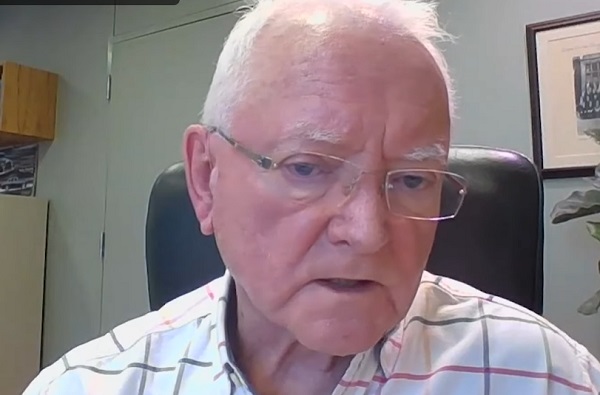Opinion
“US vs THEM” is an increasingly common philosophy today.

Councillor Handley mentioned that there was an atmosphere of “Us vs. Them” at the Westerner in regards to city hall. Partially deemed the reason for the Westerner’s financial plight.
Hospitals and schools seem to have the “Us vs. Them” in regards to the province. Covid-19 brought it to the forefront.
Alberta Premier seems to fan the flames of “Us vs, Them” in regards to Ottawa. Yet Ottawa has been doling money to Alberta in far greater amounts than the province. Pipelines and Covid-19 are 2 examples.
I can continue with all kinds of issues, like Molly Banister recently, the Aquatic Centre to name but 2 more.
With all these protectionist sectors battling each other, the fact that there is only one group of taxpayers paying for all of it, is forgotten.
Susan Delacourt wrote a column on Trumpism which thrived under the “Us vs. Them” political culture.
She included in her column;
“Frank Graves, the EKOS pollster who has been doing an intense study of populism and its potential to surface in Canada, was not feeling complacent at all as the results rolled in from the Nov. 3 vote.
Graves and Michael Valpy wrote a piece on the eve of the vote last week, and the conclusion of that article was a warning and a prediction wrapped up in four words: “Trump is still competitive.”
Quietly, methodically, Graves has been analyzing the component pieces of Trump’s appeal and what feeds the political culture of grievance that the president championed.
Much of Graves’ findings were published earlier this year in a paper for the University of Calgary’s public-policy school — a paper that should be required reading for any Canadians of the “it can’t happen here” way of thinking.
Graves has coined the phrase “ordered populism” to describe the Trump phenomenon and the paper’s summary describes it this way:
“Ordered populism rests on the belief in a corrupt elite, and the idea that power needs to be wrested from this elite and returned to the people. Oriented toward authoritarianism, ordered populism emphasizes obedience, hostility toward outgroups, a desire to turn back the clock to a time of greater order in society, and a search for a strongman type to lead the return to a better time.”
Does that type of politics exist in Canada? It sure does, Graves says, and it’s been on the rise for the past few years. His research says that view is shared by as much as a third of the population and its ascent is accompanied by increases in polarization, inequality and a decline in the middle class.”
The fact that we don’t have a true “Trump” populist strongman here does not mean the voters do not seek one.
Our Premier tried using Trump style tactics to benefit the rich oil companies and executives. Unfortunately he appears to operate solely for the few, his inner circle, the elite, and ignores the needs of the populace.
The taxpayers are constantly being told “NO”, yet it appears that there are the favored few who get everything. Public servants are being told they will be seeing a 4% cutback to their paycheque, but remember politicians, who voted themselves top up pay when their 1/3 tax subsidy ended. Home owners were deemed less important than the developer. Skaters seem more important than swimmers. Rich people need tax relief while poor people get benefits reduced.
Taxpayers in one area hear how in another area they are turning lemons into lemonade, but not here. I am talking about the county or Blackfalds , using low interest rates, low land prices, low bids to build now, at great savings, but the city says it can’t happen here. Why not? They found millions to suddenly renovate city hall. Why not look beyond their limited circle and ask? City vs. County? Red Deer vs. Blackfalds?
If the county can save $800,000 on a $2.9 million bid, could we not look to see if we could save at that ratio, $24 million on a $90 million Aquatic centre. The city keeps talking about ice rinks, life spans of current ice rinks, well the last pool we opened was 20 years ago. Do we have any plans to replace our aging swimming pools? Skaters vs, swimmers?
Again the list goes on and on.
Every where you go there seems to be the “Us vs. Them” mentality.
Perhaps we should support those who are contrarian to the wishes of the elite. Is there an updated Trump out there to lead?
Just asking.
2025 Federal Election
Trudeau and Carney Have Blown $43B on EVs

 David Krayden
David Krayden
General Motors laid off 500 workers at his Electric Vehicle (EV) plant in Ingersoll, ON.
It had nothing to do with the tariffs.
It had everything to do with the plummeting fascination that Canadians have for EVs. They are selling like used Edsels in the late 1950s. In a useless attempt to create a demand for these “green” vehicles (which aren’t actually green at all because the production of electricity does not result from magic) the governments of former Prime Minister Justin Trudeau and Ontario Premier Doug Ford wasted $42 billions of your tax money. And it was all to bolster an ideology not a demand for cars. There is no demand for these vehicles.
“You just lost 500 jobs. They’ve nuked those jobs. They’re not there anymore.”
-Dan McTeague

Ford, who saw this coming when he called an early provincial election that he knew he probably was going to lose if he waited for the anticipated vote, was actually honest to reporters when he admitted the layoffs had nothing to do with the dreaded Trump tariff but everything to do with public taste.
“What I understand from the president of General Motors that I spoke to, it’s going to be about 500 employees. Has nothing to do with the tariffs. He said, the volume is not there. People are not purchasing like they thought they would. So, they have thousands of vehicles sitting there. We make sure we support the workers and make sure that we get the government, especially Canada Post, to pick up some of these vehicles, because that’s what it’s geared for you.”

So, Ford expects Canada Post, another government agency on its last legs, to come to the rescue and pick up all these excess EVs? Sounds like it. The irony is that Ford came into office largely because the previous Liberal government had gone hog wild with its green energy program and hydro rates were among the highest in North America. Ford used to say that a industrialized province like Ontario can’t possibly prosper or even subsist on the energy provided by windmills and solar panels. He was right then but over the years he became firmly ensconced in the pocket of Trudeau and the Liberals, just as he is today with Mark Carney.

I spoke to my old friend Dan McTeague on Saturday about this mess. McTeague is a former Liberal MP from the GTA who is the president of Canadians for Affordable Energy today and well known for predicting gas prices across Canada as the @ gaspricewizard on X. As an MP, he always put principal above expediency, and he is no different today. McTeague is anxious for a Conservative Party of Canada (CPC) victory in this federal election and he is actively campaigning for a CPC nominee.

McTeague was not surprised over the dismal outlook for EVs.
“This is about Pierre Poilievre saying your policies are garbage. They’ve hurt Canadians. They’ve undermined the financial feasibility and sustainability of the federal government and the provincial government, and we’re going to get rid of them, just like we’re going to get rid of the CBC.”
-Dan McTeague
“Well, on the 22nd of March after having gone to the Ingersoll plant. I just tweeted a little while ago. I actually went there, filmed what was there in inventory. There were thousands of these vehicles just sitting there doing nothing. Obviously, Doug Ford didn’t get it on the 22nd of March. I said it says a lot about why the Ford nation is giddy about supporting Carney, he’s committed billions in world EV and battery manufacturing like this one in Ingersoll, where the provincial Feds kicked in over half a billion for bright drops. Was supposed to sell 100,000 units. Only sold 2100 actually, it got wrong. It was 2500 they might have probably given that a few away there. But look, this is anticipating what was there. It’s pretty obvious. I mean, I don’t just predict gas prices. Pretty good idea policies, EV mandates, the entire nets,” McTeague said.
McTeague explained that the “EV mandates are toast,” not just because President Donald Trump eliminated them but because they simply never had traction with consumers. He noted that Carney is playing games with the consumer carbon tax – because he hasn’t eliminated it but merely reduced it temporarily to zero – and has continued to keep emissions caps in place.
“Why are they doubling down on forcing us to have California-style appliances, which are extraordinarily costly to consumers. There are thousands of these things that are coming up. GFANZ, the Glasgow Financial Alliance for Net Zero that Mark Carney put forward, is now subject to antitrust review in the United States. This guy could be charged and billions of dollars taken away from the GFANZ organization,” McTeague said, adding that “anybody who hopped on the bandwagon a few years ago on net zero is now looking pretty damn foolish, and it’s amazing to see so many stunned Canadians falling in for this.”
“You just lost 500 jobs. They’ve nuked those jobs. They’re not there anymore.”

The former Liberal MP said the EV program is just one example of a failed economic record from the Trudeau-Carney regime. “However you slice it, the Liberals have had 10 years of failed policies. Net Zero has laid an egg. It’s not doing anything. And what they’re going to try to do is use a lot more public money and hopefully put enough wool over everyone’s eyes, so that we continue to go down this road of more recklessness as a result of what we’ve seen on EVs.
“Anybody who hopped on the bandwagon a few years ago on net zero is now looking pretty damn foolish, and it’s amazing to see so many stunned Canadians falling in for this.”
McTeague also wondered how the Ontario premier has moved from a commonsense politician on green energy to a cheerleader for Trudeau’s environmental authoritarianism. “For Doug Ford to have signed onto this. I mean, Shame on him, but it probably explains why he doesn’t want to support Pierre Poilievre.”
Said McTeague: “This is about Pierre Poilievre saying your policies are garbage. They’ve hurt Canadians. They’ve undermined the financial feasibility and sustainability of the federal government and the provincial government, and we’re going to get rid of them, just like we’re going to get rid of the CBC.”
“And so, for those reasons, you’re going to see why people are not supporting Pierre Poilievre, because they know, you know, they know which side of the bread is going to get buttered and for guys like Doug Ford, Bad mistake, back the wrong horse, and now we’re holding the bag. That’s why he called the election early.”
McTeague said the federal election is a watershed moment for people to decide what kind of future they want: prosperity or poverty. “If Canadians can’t get their head out of the sand and realize that they’re being duped that they can’t afford, you know, the saddling of the debts that these things are incurring for generations to come, and they think that somehow crapping on pipelines or putting emission caps that won’t allow us to make any more oil or gas to send these pipelines that they now suddenly have discovered are important … If we don’t wake up real soon, next two weeks, I can say confidently the next four years is basically cutting people.”
The energy expert predicted that the worst if yet to come if Carney wins a mandate to govern from the voters. “Nothing has changed, if anything, Mr. Carney and his company, as we well know, has lied on so many fronts. And here’s the big one that I’m going to say it here now, because I’ve said it many places before, but to be absolutely clear, you’re going to get a carbon tax, and that 20 cents you think you’re getting off. It’s going to be 40 cents by 2030, likely by the end of another government, “should they form a majority government.”
McTeague cautioned against Canadians becoming deluded and declaring, “Oh, we’re not worried about the future; we just don’t like Donald Trump, and we think Pierre Poilievre is like him.” Give your head a shake — because you know what, I’m going to spend a lot of time over the next few years, pointing back to the stupidity and frivolity of people. And make no mistake, David, these people know what they’re doing. They’re just trying to be cool and friendly because they made mistakes in 2015, 2019 and again in 2021 and they want to somehow think that they can justify bad decisions. What’s coming at the expense of the country? Coming at the expense of our economic sustainability? It’s likely coming at the expense of what concerns me even more so: the future of the federation of this country.”
“I’ve said it many places before, but to be absolutely clear, you’re going to get a carbon tax, and that 20 cents you think you’re getting off. It’s going to be 40 cents by 2030.”
Dan and I also discussed how he has discovered that much of the polling being conducted during this campaign is over-sampling people over 60, which comprise at least 50 percent of the respondents included in the surveys. This bodes well for Poilievre and the Conservatives.
Tomorrow I will be examining how the Consevatives are appealing to working class Canadians, labor union leaders and blue collar workers. Seeking and winning the “hard hat vote” worked for President Richard Nixon in 1972 and President Ronald Reagan in 1984. It can work for Poilevre too in 2025 — and somehow I think he realizes that.
WATCH: The Ugly Truth About Carney: Trudeau Subsidies Fail
CHECK OUT OUR KR NEWS INVESTIGATIVE SERIES ON MARK CARNEY

Rich Banker Man Mark Carney Caught by CBC & CTV Dodging Taxes

Liberal MP Encouraged the Abduction of Conservative Rival for Chinese Bounty

KR NEWSLETTER: Mark Carney to “Fold” “After the vote.” Carney’s Wife’s Eurasia Group Boss Spills the Beans on the Liberals’ “Elbows Up” Master Plan

GFANZ, Mark Carney’s Climate Cabal That Won’t Leave Us Alone

Mark Carney’s is China’s Man

KRN NEWSLETTER: Mark Carney Deep Dive + Disastrous Liberal Leadership Debates
2025 Federal Election
Mark Carney Vows Internet Speech Crackdown if Elected


By
Mark Carney dodges Epstein jabs in Hamilton while reviving failed Liberal plans for speech control via Bill C-36 and Bill C-63.
|
It was supposed to be a routine campaign pit stop, the kind of low-stakes political affair where candidates smile like used car salesmen and dish out platitudes thicker than Ontario maple syrup. Instead, Mark Carney found himself dodging verbal bricks in a Hamilton hall, facing hecklers who lobbed Jeffrey Epstein references like Molotovs. No rebuttal, no denial. Just a pivot worthy of an Olympic gymnast, straight to the perils of digital discourse.
“There are many serious issues that we’re dealing with,” he said, ignoring the criticism that had just lobbed his way. “One of them is the sea of misogyny, antisemitism, hatred, and conspiracy theories — this sort of pollution online that washes over our virtual borders from the United States.”
Ah yes, the dreaded digital tide. Forget inflation or the fact that owning a home now requires a GoFundMe. According to Carney, the real catastrophe is memes from Buffalo.
The Ghost of Bills Past
Carney’s new plan to battle the internet; whatever it may be, because details are apparently for peasants, would revive a long-dead Liberal Party obsession: regulating online speech in a country that still pretends to value free expression.
It’s an effort so cursed, it’s been killed more times than Jason Voorhees. First, there was Bill C-36, which flopped in 2021. Then came its undead cousin, Bill C-63, awkwardly titled the Online Harms Act, which proposed giving the Canadian Human Rights Commission the power to act as digital inquisitors, sniffing out content that “foments detestation or vilification.”
Naturally, it died too, not from public support, but because Parliament decided it had better things to do, like not passing it in time.
But as every horror franchise teaches us, the villain never stays away for long. Carney’s speech didn’t include specifics, which is usually code for “we’ll make it up later,” but the intent is clear: the Liberals are once again oiling up the guillotine of speech regulation, ready to let it fall on anything remotely edgy, impolite, or, God forbid, unpopular.
“Won’t Someone Think of the Children?”
“The more serious thing is when it affects how people behave — when Canadians are threatened going to their community centers or their places of worship or their school or, God forbid, when it affects our children,” Carney warned, pulling the emergency brake on the national sympathy train. It’s the same tired tactic every aspiring control freak uses, wrap the pitch in the soft fuzz of public safety and pray nobody notices the jackboot behind the curtain.
Nothing stirs the legislative loins like invoking the children. But vague terror about online contagion infecting impressionable minds has become the go-to excuse for internet crackdowns across the Western world. Canada’s Liberals are no different. They just dress it up and pretend it’s for your own good.
“Free Speech Is Important, But…”
Former Heritage Minister Pascale St-Onge, doing her best impression of a benevolent censor, also piped up earlier this year with a classic verbal pretzel: “We need to make sure [freedom of expression] exists and that it’s protected. Yet the same freedom of expression is currently being exploited and undermined.”
Protecting free speech by regulating it is the sort of logic that keeps satire writers out of work.
St-Onge’s lament about algorithms monetizing debate sounds suspiciously like a pitch from someone who can’t get a word in on X. It’s the familiar cry of technocrats and bureaucrats who can’t fathom a world where regular people might say things that aren’t government-approved. “Respect is lacking in public discourse,” she whined on February 20. She’s right. People are tired of pretending to respect politicians who think governing a country means babysitting the internet.
|
|
|
|
Powerful forces want to silence independent voices online
|
|
Governments and corporations are working hand in hand to control what you can say, what you can read; and soon, who you are allowed to be.
New laws promise to “protect” you; but instead criminalize dissent.
Platforms deplatform, demonetize, and disappear accounts that step out of line.
AI-driven surveillance tracks everything you do, feeding a system built to monitor, profile, and ultimately control.
Now, they’re pushing for centralized digital IDs; a tool that could link your identity to everything you say and do online. No anonymity. No privacy. No escape.
This isn’t about safety, it’s about power.
If you believe in a truly free and open internet; where ideas can be debated without fear, where privacy is a right, and where no government or corporation dictates what’s true; please become a supporter.
By becoming a supporter, you’ll help us:
We don’t answer to advertisers or political elites.
If you can, please become a supporter. It takes less than a minute to set up, you’ll get a bunch of extra features, guides, analysis and solutions, and every donation strengthens the fight for online freedom.
|
|
-

 2025 Federal Election2 days ago
2025 Federal Election2 days agoLiberals Replace Candidate Embroiled in Election Interference Scandal with Board Member of School Flagged in Canada’s Election Interference Inquiry
-

 Alberta2 days ago
Alberta2 days agoIs Canada’s Federation Fair?
-

 Alberta2 days ago
Alberta2 days agoProvince introducing “Patient-Focused Funding Model” to fund acute care in Alberta
-

 espionage2 days ago
espionage2 days agoU.S. Experts Warn Canada Is Losing the Fight Against PRC Criminal Networks—Washington Has Run Out of Patience
-

 COVID-191 day ago
COVID-191 day agoMassive new study links COVID jabs to higher risk of myocarditis, stroke, artery disease
-

 Alberta1 day ago
Alberta1 day agoMedical regulator stops short of revoking license of Alberta doctor skeptic of COVID vaccine
-

 International1 day ago
International1 day agoUN committee urges Canada to repeal euthanasia for non-terminally ill patients
-

 Automotive2 days ago
Automotive2 days agoTesla Vandals Keep Running Into The Same Problem … Cameras



